Yonderre: Difference between revisions
Tag: 2017 source edit |
m →Sports Tag: 2017 source edit |
||
| Line 455: | Line 455: | ||
[[Category:Levantine Union]] | [[Category:Levantine Union]] | ||
[[Category:Countries]] | [[Category:Countries]] | ||
[[Category:IXWB]] | [[Category:IXWB]] | ||
{{Template:Award winning article}} | {{Template:Award winning article}} | ||
[[Category:2022 Award winning pages]] | [[Category:2022 Award winning pages]] | ||
[[Category:2023 Award winning pages]] | [[Category:2023 Award winning pages]] | ||
[[Category:2024 Award winning pages]] | |||
Revision as of 11:55, 17 October 2024
Most Serene Grand Duchy Yonderre | |
|---|---|
Motto: Nam Claritas Dei For the Glory of God | |
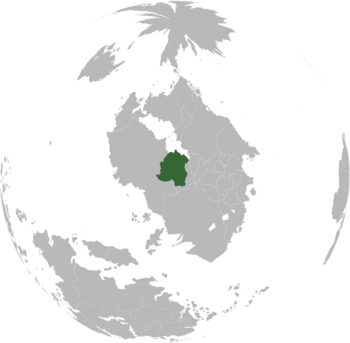 Yonderre within Levantia | |
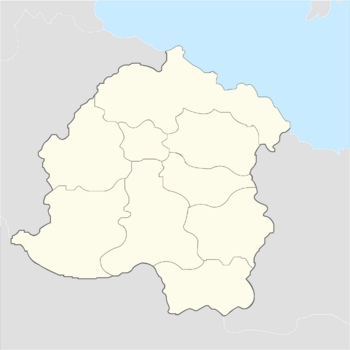 Mainland Yonderre divided in nine counties | |
| Capital and largest city | Collinebourg |
| Official languages | Burgoignesc Gothic |
| Religion | Catholic Church |
| Demonym(s) | Yonderian Yond |
| Government | Federal parliamentary elective constitutional monarchy |
| Auguste IV de Somua | |
| Hercule d'Arcaneaux (UY) | |
| Legislature | Yonderian Parliament |
| Establishment | |
| 1458-1474 | |
| 1494 | |
| 1833 | |
| Area | |
• Total | 1,261,724 km2 (487,154 sq mi) |
| Population | |
• 2028 estimate | 100,235,660 |
• Density | 79.4/km2 (205.6/sq mi) |
| GDP (nominal) | 2028 estimate |
• Total | $6.218.676.478.369,6 |
• Per capita | $62,040.56 (3rd) |
| Currency | Taler (₮) |
| Date format | dd-mm-yy |
| Driving side | right |
| Calling code | +216 |
| Internet TLD | .yon |
Yonderre, officially styled as the Most Serene Grand Duchy Yonderre (Burgoignesc: Sérénissime Grand-Duché Yonderre, Gothic: Heilige Großherzogtum Yonderre), is a nation in Levantia. Its capital and most populous city is Collinebourg. Yonderre consists of nine Counties that are divided into 72 Baronies, each of which further subdivides into munincipalities. The Kestrel Isles of the Vandarch Sea form a seperate Grand Barony directly under the Grand Duke of Yonderre. Yonderre neighbours Faneria and Hendalarsk across the Vandarch to the north via the Kestrel Isles, Hollona and Diorisia to the east, Anglei to the southeast, Carnland to the southwest and Eldmora to the west. Yonderre is a semi-landlocked country on the Vandarch south coast, having access to the Kilikas Sea via the Grand Vandarch Canal which is administered by the Marine Yonderre.
Yonderre has been inhabited since at least 10,000 BC by proto-Gothic and Khovihnihk tribes. The Bronze and Iron Ages were characterised by extensive contacts with other cultures in Catholic Levantia and Ultmar. Known as East Gothica to Great Levantia, Yonderre became a crossroads of trade between Catholic Levantia and Ultmar around the late Bronze Age. The Great Gothic Migration which happened around the fall of the Levantine Potentate in the late 6th century AD drove the Khovihnihk tribes out of East Gothica in a matter of decades, afterwhich several attempts to form a centralized Gothic nation failed. The resultant wealth of independent or semi-independent Gothic nations coexisted mostly peacefully with its foreign neighbours albeit in a near constant state of internal turmoil until the latter half of the 15th century saw East Gothica conquered by crusaders from the Holy Levantine Empire, establishing Yonderre as an autonomous marcher realm under Joanus de Martigueux. Yonderre's legitimacy was solidified by the Treaty for the guarantee of Joanus' Land signed with the Holy Levantine Empire in 1494.
Despite a largely succesful transition from the East Gothic faith to Catholicism, settlers from the Holy Levantine Empire raised ethnic and cultural tensions throughout the late fifteenth and sixteenth centuries. The chiefly Bergendii settlers established new villages or became wealthy burghers in the new cities settled by the crusaders, while the indigenous Gothic population were entrenched in serfdom under their new Levantine Catholic nobility. Following a number of smaller uprisings, this ultimately concluded in the First Potato War (1556-1557) and the Yonderian Peasants' War of the mid-1640s, widespread uprisings throughout Yonderre both of which ultimately failed. Yonderre was the main combatant of the Likedealers during the Golden Age of Vandarch Piracy in the late 18th century, policing the south Vandarch. Yonderre had its final civil war, the Second Potato War, between 1787-1788, which resulted in relaxed taxation and granted more rights to the peasantry. Yonderre prospered throughout the 19th century in what is known as the Yonderian Golden Age, a time of exceptional creative production in the fields of culture and science. Yonderre persued a strict policy of neutrality throughout the Great Wars, although more than 1.5 million Yonderians served in the Burgoignesc Foreign Legion as volunteers. Yonderre joined the Levantia and Odoneru Treaty Association in the aftermath of the Second Great War and the Yonderian Defence Force has partaken in numerous peacekeeping operations around the world since then, notably Operation Khyzer Rhykh and the Deluge.
Yonderre is a middle power with a strong economy, having the world's third-largest economy by GDP per capita at $62,040.56. A highly developed country, Yonderians enjoy a high standard of living and the country offers social security and a universal health care system, environmental protections, and a tuition-free university education. Yonderre ranks highly in most metrics of national performance, including education, health care, protection of civil liberties, democratic governance and gender equality. Yonderian cuisine is famous worldwide, particularly for its pastries and beers. Yonderre is a member of the Levantine Union and the Talerzone and was a member of the Levantia and Odoneru Treaty Association from 1958 until its dissolution and replacement in 2018 by the Levantine Union Defense Council, of which Yonderre is a founding member.
Etymology and title
Yonderre takes its name from the Treaty for the guarantee of Joanus' Land wherein the lands making up Yonderre are mentioned as Joanusterra, "Joanus' land" from Latin Terra, in reference to Joanus de Martigueux, the first Crusader Grand Count of Yonderre. The styling of the name was changed over time, with the more Burgoignesc-sounding Yoansterre appearing side-by-side with Joanusterra throughout the sixteenth century. The present spelling of the name is first documented in the early seventeenth century and is thought to have replaced the others almost entirely by time of the Yonderian Peasants' War in the 1640s. Yonderre has sometimes historically been referred to as Jondaar and Jonderd in the East Gothic language after the Conquest of Joanusterre, although this name has amost entirely fallen out of use in favour of the official style. Prior to the Conquest of Joanusterra, present-day Yonderre was often referred to simply as East Gothica or Gothica. This was due to the nature of the plethora of independent or semi-independent Gothic nations that existed between the Great Gothic Migration of the late sixth century and the Conquest of Joanusterra, effectively making the borders of modern Yonderre a geographical region.
The title of Most Serene Grand Duchy was conferred on Yonderre by Pope Gregory XIII in 1574 following lengthy negotiations. The Yonderian nobility had wanted the nation raised to the status of a Kingdom but due to stipulations in the Treaty for the guarantee of Joanus' Land, Yonderre could not be made a Kingdom as it was tied to the Crown of the Holy Levantine Empire de jure, despite the treaty having made Yonderre de jure autonmous and de facto independent in 1494.
History
Pre-history and antiquity (before the 6th century AD)
Archaeological digs around Yonderre indicate that much of Yonderre has been inhabited by humans since at least the paleolithic period, based in part on dating of shards of pottery. Burial mounds, some in excess of 5,000 years old, dot the Yonderian landscape. Different styles exist and are generally divided into three groups: Gothic, Ænglish and Khovihnihk. Studies of the genetic makeup of Stonne's prehistoric inhabitants show a high frequency of the y-chromosome haplogroup G2g, a common genetic trait amongst the Gothic peoples, indicating that Goths, or perhaps rather proto-Goths, already inhabited what is today Yonderre before agriculture was developed in Gothica.
Gothic middle ages (6th–15th century)
The middle ages began in Gothica with the Great Gothic Migration ocurring around the fall of the Levantine Potentate in the late 6th century AD. The lands making up modern Yonderre had beforehand been home to Goths but also Ænglish people and Khovihnihk tribes. The Khovihnihk tribes were driven out of East Gothica in a matter of decades while a rump of the Ænglish remained in the far east. Will of Wandsberg attempted to form a united Gothic nation in the late sixth century, securing much of eastern East Gothica but ulitmately failing. Several attempts to form a centralized Gothic nation followed and all ultimately failed, leading to endless infighting and wars between Gothic nobility. Gothic lords went by Höwding, "Chieftain" (Literally "Headling"), until a general trend towards titles of nobility mimicking those of the Levantine Empire occured around the late ninth century.
While written sources from early medieval East Gothica are few and far between (often attributed to a preference for oral tradition), the few available sources are able to shed light on East Gothic societies and tradition. One of the few examples of very early medieval sources available is in a c. 750 AD tome written by Opthéin, a monk of Canaery. Opthéin travelled through much of what today constitutes the Yonderian Counties Amarre and Montgebirre and recounted his tales in the Gesta Gothica. The Gesta Gothica relates Gothic society and traditions and compares his findings with those of the Levantine Empire. Opthéin paints a picture of the Goths as a type of noble savages, not un-cultured but still un-Christian, which Opthéin saw as one of their greatest failings. Opthéin also notes that while the cities of East Gothica were generally safe, the roads and woodlands between them were home to bandits and "robber barons".
Dan Lärdmann writes in his ninth century Chronica Gothica of advances to Gothic society made during the latter half of the century. A trend of approachment with the Levantine Empire was in the Zeitgeist according to Lärdmann, and with it an interest in adopting new ideas from Catholic Levantia, albeit without compromising Gothic identity. The late medieval period was characterized by further power struggles as Gothic nobles continued to attempt to unite Gothica. Impressive walled castles were constructed throughout Gothica and became prestigious status symbols outside of their obvious protective qualities while banditry continued to inhabit rural Gothica. Religious missions from the Holy Levantine Empire became more common during this period, but these were largely unsuccesful and more often than not were assaulted while travelling between cities and robbed, killed or captured and ransomed off, a trend that eventually became a leading factor in the Catholic Church calling for crusades into Gothica.
Crusader conquest of Joanusterra (1458–1474)
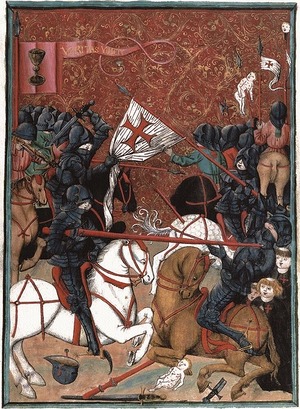
In the aftermath of the failed crusade of the Ænglish, Pope Callixtus III called for another crusade into Gothica. The call was answered by many Deric lesser nobles who amassed with their retinues in Ænglasmarch in early 1458. The crusaders led by Count of Estia Joanus de Martigueux entered Gothica from the east by the Vollardic Mountains, headed for the city of Koop. Proselytism and looting occured interchangably as the crusaders headed for Koop, meeting no major resistance until encountering an amassed army of East Gothic lords and their levies in Willersthal under the leadership of King Widukind of Weferlingen. On the 23rd of August, 1458, in what became known as the Battle of Willersthal, the numerically superior Gothic forces were destroyed, outmaneuvered and outclassed by de Martigueux's mounted heavy cavalry forces. The crusaders took the mercantile hotspot Willing largely unopposed, its lord Holger slain and soldiers killed or captured at Willersthal.
Having wintered in Willing and received reinforcements from the Holy Levantine Empire, the crusaders set out again in early 1459 and soon had much of modern Vollardie County under control. Major battles were few, much of Gothica's principal leadership having been killed or captured at Willersthal. Sieges were common, as Gothic lords attempted to hide out the conquest in their walled castles. Some Gothic lords like Eberhard the Sentinel and Markvart von Talerbeck were christened voluntarily and joined the ranks of the crusaders. The Order of the Knights of the Oblong Table was officially formed in 1462 as an inner circle of most trusted allies to de Martigueux. What is today the modern Yonderian Collinebourg County was conquered at around this time, and de Martigueux let his castle Collinebourg be built on a hill overlooking the Peritonne River in 1464, from which the future capital of Yonderre Collinebourg soon grew out.
Another major battle occured in 1466 at Tuburg in Södarland when another combined force of allied Gothic lords attacked a crusader army under Eberhard the Sentinel. The Battle of Tuburg ended in another Gothic defeat that left Södarland largely undefended. The city of Tuburg fell after a short siege over the winter 1466/67 and most of Södarland followed suit. The crusader armies at this time boasted impressive military capabilities, being experts at siege warfare and heavy cavalry tactics. Gothic levies were beginning to be integrated into the crusader armies but largely mistrusted by their Deric counterparts. A southern campaign to the modern border of Carnland began in the late 1460s and was largely uneventful.
Beginning in 1470, the crusaders under de Martigueux once more amassaed a major force to assault westward towards the Donne River. A number of major sieges occured, notably that of Donburg which lasted almost two years from 1471-1473. With the Gothic nobility in East Gothica unseated and their lands occupied, de Martigueux announced that the crusaders stood victorious and that their crusade had reached its end. A period of rebuilding and further proselytising followed the sixteen years of conquest. de Martigueux divided the conquered lands between the Knights of the Oblong Table in a fashion which laid out the boundaries of the modern Counties of Yonderre. Petitions from de Martigueux to let his new realm be absorbed into the Holy Levantine Empire were denied by orders of Pope Sixtus IV to deny the Emperor more power. What followed instead was the signing of the Treaty for the guarantee of Joanus' Land between de Martigueux and Pope Alexander VI in 1494, which established Joanusterra as an independent realm.
Early modern period (Late 15th century–1820)
Wars of the early modern period

In the period between the Conquest of Joanusterra and the Yonderian Golden Age, Yonderre witnessed three major civil wars all of which were either based on or heavily influenced by cultural tension between the (typically) Gothic peasantry and the mostly Bergendii clergy and nobility. The first of these was the First Potato War which broke out in 1556. The war was named as such for the laws in effect at the time that forbade the growing of potatoes in Yonderre by the Gothic peasantry, but in reality the war is more likely an off-shoot of the concurrent Great Confessional War. The rebellion was struck down handily by the Knights of the Realm under Joanus II de Donne in 1557 who subsequently further limited the freedom and rights of the peasantry.
Yonderre's second civil war, the Yonderian Peasants' War, was a widespread popular revolt that broke out in 1641 led by disgruntled Knights of the Realm against the Yonderian nobility. The war began with separate insurrections in Donne and Kubagne and soon spread to Amarre. The revolt incorporated some principles and rhetoric from the Protestant Reformation through which the peasants sought influence and freedom, and much of the conflict echoed the First Potato War and as such the Great Confessional War. Though the rebels were initially succesful, the war ended in 1643 with the decisive Battle of Stonne in which the peasant army was soundly defeated by loyalist Knights of the Realm and levies. The end of the Yonderian Peasants' War led to an overall reduction of rights and freedoms of the peasant class, effectively pushing them out of Yonderre's political life until the Yonderian Golden Age. As a direct result of the war, the Custodes Yonderre was formed in 1643 as a police force to maintain law and order in major cities, while the plans for a new system of armed forces were finalized the next Summer with the creation of the Grand Ducal Army.
Yonderre was the main combatant of the Likedealers during the Golden Age of Vandarch Piracy in the late 18th century, policing the south Vandarch. The Likedealers were a loosely organized guild of pirates whose operations greatly affected maritime trade in both the Kestrel Isles and on the coasts of the greater Vandarch. The scourge of the Likedealers was finally brought to an end in a battle in 1785 that became known as the Last stand of the Likedealers, in which the Marine Yonderre managed to entrap and destroy the Likedealers' leadership. The battle proved to effectively be the end of piracy in the Vandarch. Just two years later, the last of Yonderre's civil wars, the Second Potato War, ended with the rebelling peasantry soundly defeated in 1788, but unlike the previous Yonderian Peasants' War of 1641-43, Grand Duke of Yonderre Auguste III de Somua made concessions to the peasantry, abolishing the highly unpopular Potato Laws that had caused the war in the first place and clearing the path for a period of societal reform that came to be known as the Yonderian Golden Age.
Yonderian Golden Age (1820–1900)
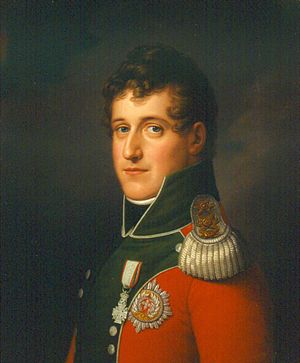
The Yonderian Golden Age is a name given by historians and sociologists to a period of exceptional social, scientific and cultural advances that took place in Yonderre during the nineteenth century. Historians and sociologists disagree on the exact start and end dates of the period, but a widely accepted consensus is that Michael Falks's book My Yonderre released in 1820 was the catalyst that started the period. End date is generally accepted as the start of the twentieth century, but are also variously given as 1890s and even up to the end of the 1900s with the beginning of the Great Depression.
The creation of a singular Yonderian culture across the previous boundaries of Burgoignesc and Gothic cultures is often lauded as the greatest achievement of the Yonderian Golden Age. The 1820s and 30s were a period of major social reform in Yonderre with the introduction of reforms for the peasantry, the signing of the Constitution of Yonderre in 1833 which brought with it the Yonderian Parliament, reforms to the Custodes Yonderre and a common code of law across all Counties of Yonderre. Neo-classical architecture became the dominant style of the period, leaving a distinct look to major cities like Collinebourg and Gabion. Scientific advances were made in several fields by Yonderians including physicist Rachet d'Everard, chemist Eberhard Sass, philosopher Hieronymus von Kähler and paleontologists Killian Lange and Thibaut d'Avignon. The period also brought with it major advances in the arts such as the prime of Anders von Necksee whose idealized paintings of rural Yonderre received international acclaim and playwright Hieronymus d'Olbourg whose historical plays like Siegmar the Iron-Handed and Löwenschiold played an important part in the shaping of Yonderian national romanticism.
A critical factor for the start of the period was the increase in literacy in Yonderian society and improvements in printing technology, both of which allowed the exchange of ideas at a much faster rate than previously possible. Another crucial component was the Grand Duke of Yonderre Falco IV Sentinelleau, whose election and ascension to the throne in May of 1820 brought with it a milieu in which major social reform was not only possible but probable. Urbanization, caused in no small part by industrialization and the doubling of Yonderre's population between 1760-1860, was also a leading factor in the creation of a common Yonderian culture.
The Constitution of Yonderre was signed into power on June 10, 1833. The Constitution defined Yonderre as a constitutional monarchy, governed through a parliamentary system with executive powers wielded by the Grand Duke. It created separations of power between the Yonderian Parliament, which enact laws, the government, which implements them, and the courts, which makes judgment about them. It also granted some fundamental rights to citizens of Yonderre including freedom of association and freedom of assembly. Most importantly for a united Yonderian culture, the Consitution did away with distinctions of Gothic and Bergendii citizens, instead referring directly to Yonderians.
Contemporary period (1900–present)
Universal manhood suffrage was introduced in Yonderre in 1903, allowing male citizens of Yonderre over the age of 25 to vote in Federal County elections while maintaining the Grand Vote for national elections. In 1915 voting rights were extended to eligible men 22 years of age, and in 1922 to women, a movement spearheaded by the Social Democrats. Yonderre pursued a strict policy of neutrality throughout the Great Wars. In the First Great War, this included limiting exports and imports with warring nations, a policy that would prove to be a contributing factor in the 1909 Great Depression and its effects in Yonderre. The Great Depression briefly crippled the Yonderian economy and brought with it a long period of economic stagnation that lasted almost two decades until Grand Duke Joanus X de Martigueux and the Social Democratic cabinet under Adolphe Heineau instituted major economic reforms in the 1920s that would prove succesful. Around the time of the Second Great War in the mid-1930s, Yonderian economic and industrial capacity was increasing, reaching pre-Great Depression levels again in the 1940s.
During the Second Great War more than 1.5 million Yonderians served in the Burgoignesc Foreign Legion as volunteers, representing more than 5% of Yonderian men and more than 2.5% of the total Yonderian population of 59.5 million (1940). At it's height in 1938, the Yonderian contingency of the Burgoignesc Foreign Legion numbered more than 300.000 men under arms, chiefly in frontline units. The volunteers became known as the Volonderre-movement and would have considerable influence on Yonderre during the Occidental Cold War. Following an upturn in the Yonderian economy and a veritable baby boom in the aftermath of the Second Great War increasing Yonderre's population from 60 million in 1940 to 90 million in the 1970s, Yonderre began to invest heavily in the 1950s in a socio-economic model including a comprehensive welfare state and multi-level collective bargaining based on the economic foundations of social corporatism, and a commitment to private ownership within a market-based mixed economy. Yonderre joined the Levantia and Odoneru Treaty Association (LOTA) in 1958, moving away from its pervious stance on neutrality largely thanks to the Volonderre-movement. Yonderre began investing heavily in nuclear energy in the 1960s to replace previous coal-powered power plants.
Geography
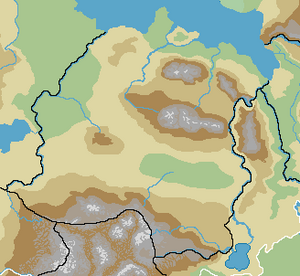
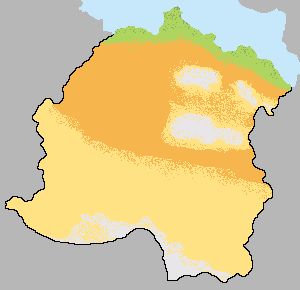
Legend:
Location and borders
Yonderre covers 1,261,724 km2 (487,154 sq mi) and is situated immediately on the historic border between Ultmar and Catholic Levantia, because of which it has enjoyed a status as a mercantile crossroads between the two since at least the Bronze Age. The western border of Yonderre shared with Eldmora runs along the Donne River, while the eastern border with Anglei is made up of the river Avonne. Yonderre shares a border southwardly with Carnland across the Gebirre Mountains. The Yonderian Kestrel Isles constitute a Grand Barony directly under the Grand Duke of Yonderre and are situated immediately north of mainland Yonderre as part of the Kestrel Isles.
The northernmost point of mainland Yonderre is the Pointe-du-Noque on the Vandarch coast, while the northernmost city is Famichez in Vandarcôte County. The southernmost point in Yonderre is Mont Carrie, a rocky outcrop on the border between Anglei and Yonderre, while the southernmost settlement is Adrienville, Montgebirre County. Yonderre's westernmost city is Tamagne of Kubagne County while the easternmost city is Ensing in Vandarcôte County bordering Hollona and Diorisia.
Geology, topography and hydrography
The most prominent geologic-topographic feature in Yonderre, the Vollardic Mountains, is mostly made up of granite and granitic-gneisses. The assemblage of its terranes is thought to have involved the closure of at least two major basins containing oceanic crust and marine sediments. This is reflected in the ophiolites, basalts, blueschists and eclogites that occur in-between terranes. Western Yonderre is dominated by gneiss and bunter sandstone. Excluding the Vollardic and Gebirre Mountains, Yonderre is generally a country consiting of rolling hills and flat plains situated just around sea level.
Hydrographically, Yonderre lies at the end of the Vandarch sea where the salinity is at its lowest at 0.3%, thus being borderline-freshwater. The lack of salinity is due to the abundant freshwater runoff from the surrounding land (rivers, streams and alike). The water level is generally far more dependent on the regional wind situation than on tidal effects. Tides can reach 17 to 19 cm in the Gulf of Gabion.
Climate and environment
Northern Yonderre lies within the coastal climate afforded by the Vandarch Sea. The County of Vandarcôte and the Kestrel Isles have a broadly mediterranean climate, even categorized as tropic in certain places closest to the Vandarch like Gabion and Vandarcholme. The northern Counties Collinebourg, Donne and Moncheval are generally classified as being of a humid sub-tropic nature. Vollardie County, while geographically in northern Yonderre, experiences a more temperate climate owing to the Vollardic Mountains, themselves a highland climate. Southern Yonderre, meaning the Counties Amarre, Kubagne, Montgebirre and Somua are generally temperate in nature, whilst the sourthwest of Montgebirre and parts of southeastern Kubagne are dominated by a highland climate around the Gebirre Mountains.
Administrative divisions
The Serene Grand Duchy Yonderre is divided into nine Counties and a Grand Barony that are further divided into a number of baronies, each of which further subdivides into munincipalities. The system of Counties and Baronies came about at the time of the Conquest of Joanusterra and remain largely unchanged since 1494 with the Treaty for the guarantee of Joanus' Land. The Counties and the Grand Barony of the Kestrel Isles are displayed in the table below:
| Name | Capital | Population | Coat of Arms | Location |
|---|---|---|---|---|
| County of Amarre | Toubourg | 10,840,697 | 
|

|
| County of Collinebourg | Collinebourg | 12,204,216 | 66px | 
|
| County of Donne | Donnebourg | 11,952,430 | 66px | 
|
| County of Kubagne | Sainte-Catherine | 11,430,226 | 
|

|
| County of Moncheval | Nouvelle-Vilauristre | 4,925,941 | 66px | 
|
| County of Montgebirre | Saint-Jule-du-Mont | 4,320,501 | 66px | 
|
| County of Somua | Vallonbourg | 7,903,235 | 66px | 
|
| County of Vandarcôte | Gabion | 20,402,143 | File:Vandarcote Coat of Arms.png | 
|
| County of Vollardie | Willing | 9,850,322 | 
|

|
| Grand Barony of the Kestrel Isles | Falcsbourg | 736,871 | 
|

|
Flora and fauna
Phytogeographically, Yonderre is shared between the Northwestern and Southern Levantine provinces of the Boreal Kingdom. The plants and animals of Yonderre are those generally common to central Levantia. Beeches, oaks, and other deciduous trees constitute one-third of the forests; conifers are increasing as a result of reforestation. Spruce and fir trees predominate in the Gebirre and Vollardic Mountains, while pine and larch are found in sandy soil. There are many species of ferns, flowers, fungi, and mosses. Fish abound in the rivers and the Vandarch. Wild animals include deer, wild boar, mouflon, fox, badger, hare, lynx, gray wolf, brown bear, Levantine bison and small numbers of beaver. Various migratory birds cross Yonderre in the spring and autumn.
| Flora and fauna of Yonderre | ||||

|

|

|

|

|
| Levantine kestrel | Kossaque fox | Vandarch pike | Red deer | Central Levantine boar |

|

|

|

|

|
| Oak | Carnation | Pine | Birch | Ash |

|

|

|

|

|
| Common pheasant | Wolf | Rook | Common roach | Perch |

|

|

|

|

|
| Valerian | Marigold | Wild mint | Dandelion | Common nettle |
Government and politics
Government and law

The Yonderian monarch is the Grand Duke. Yonderre is an elective Grand Duchy with elections held immediately following the death of the incumbent Grand Duke. The resultant election is the traditional vote between the nine Counts of Yonderre, one of which ultimately ascends to the status of Grand Duke. Below the Grand Duke is the Yonderian Parliament, a unicameral national legislature headed by the Grand Steward of Yonderre. Established in 1833, it meets in Gillaumebourg in central Collinebourg.
The Parliament passes all laws, approves the cabinet, and supervises the work of the government. It is also responsible for adopting the state's budgets and approving the state's accounts. As set out in the Yonderian Constitution, the Parliament is directly subordinated to the Grand Duke of Yonderre who wields executive power to veto and overturn laws passed by government. In practice, however, the Grand Duke seldom interferes in the work of the parliament. The Parliament consists of 199 elected representatives. General elections must be held every five years, but it is within the powers of the Steward of the Realm to ask the monarch to call for an election before the term has elapsed. On a vote of no confidence, the Parliament may force a single Minister or the entire government to resign.
In accordance with the Yonderian Constitution, legal power is split three-way in Yonderre; executive-, legislative- and judicious power. The executive power is wielded by the Grand Duke of Yonderre, on whose behalf civil servants and the Custodes Yonderre, the Yonderian national police force, maintains law and order. The legislative power is wielded by the Yonderian Parliament. Judiciary power is wielded by the courts of Yonderre.
Policing

The national police force of Yonderre is the Custodes Yonderre. As of 2026, the Custodes Yonderre employs 227,697 people, of which 174,256 are sworn in as officers and 53,423 are civillian employees. Custodes are constitutionally empowered to enforce the law and to effect public and social order, as well as being responsible for border control. Officers of the Custodes Yonderre are referred to as "Custode" in Burgoignesc and "Kustode" in Gothic, and the Chief of Police is referred to as the "Supreme Custodian".
The Custodes Yonderre was first formed in 1643 in the immediate aftermath of the Yonderian Peasants' War. Custodes were initially focused around large cities to enforce law and order, while villages and outlying areas maintained their local watchmen and catchpoles for decades to come. The Custodes Yonderre was reformed in 1833, written into its more modern form as part of the Consitution of Yonderre. The Custodes Yonderre then replaced the previous local and county-based watchmen organisations and nationalized and standardized policing across Yonderre with the introduction of a common code of law across all Counties of Yonderre in 1836.
Custodes Yonderre also processes licenses and permits such as gun licenses, national ID cards and passports, and furthermore, enforces immigration decisions by the Yonderian Immigration Service. Local police must also be notified when organizing public events that may significantly influence local public security and traffic.
Military
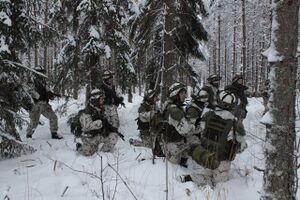
The Yonderian Defence Force is the military of the Most Serene Grand Duchy Yonderre. The primary arm of the Yonderian Defence Force is the ground force, which also operates the Army of the Air and the Marine Yonderre. The ground element of the Yonderian Defence Force consists of ten standing divisions divided into two corps, the Grand Ducal Guard Corps and the Second Corps of the Army. In adition, the Yonderian Defence Force also operates a further ten skeletonized divisions, brigade-sized units intended to be mobilized from reserves and combat ready within three days in case of national emergency. Yonderre's official policy states that a wartime military strength of 580,000 personnel constitutes a sufficient deterrent to exterior aggression. The army consists of a highly mobile field army backed up by local defence units. The army defends the national territory and its military strategy employs the use of the heavily forested terrain and numerous lakes to wear down an aggressor, instead of attempting to hold the attacking army on the frontier.
The Army of the Air operates some 275 fixed-wing combat aircraft divided into 21 wings as well as a similar number of logistical aircraft. The Army of the Air also operates an arsenal of combat helicopters as well as search and rescue helicopters. The Marine Yonderre is the Navy of Yonderre and operates two Sentinelle-class helicopter carriers, four Vigilante-class frigates, six Infatigable-class corvettes and a wide array of smaller support and auxillary ships. The Marine Yonderre is also the administrating body of the Grand Vandarch Canal.
The Yonderian Defence Force is committed to peacekeeping operations worldwide and has been in the Pukhtun Sea as part of Operation Khyzer Rhykh since 2010. The Yonderian Defence Force has been an active party in the Deluge since 2016, the Army of the Air having led a succesful air campaign against Algoquonan militias in Operation Mission Shield and all YDF branches having fought as part of the later Operation Western Blizzard. The Yonderian Defence Force was also directly involved militarily in Cetsencalia and Quetzenkel during the Final War of the Deluge, fighting on land, air and sea.
Economy

The economy of Yonderre is a highly developed social market economy with state-ownership in strategic areas. The service sector has come to play a significant economic role, particularly the Yonderian food industry and tourism, though the country remains one of the largest arms manufacturers on the planet. With a gross domestic product of $6.287 trillion, Yonderre possesses the 13th-largest economy worldwide and the fourth largest economy in the Levantine Union, while it's GDP per capita ranks 3rd globally, after Cartadania and Caphiria, at $62,040.56, by far the largest in the LU. It is the richest country per capita to not border an ocean.
Once a predominantly agricultural country on account of its arable landscape, a liberalisation of import tariffs in 1788 following the Second Potato War marked the end of mercantilism and further liberalisation in the ninetenth and the beginning of the tweentieth century established the Yonderian liberal tradition in international trade that was only to be broken by the Second Great War. Even when other countries raised protection for their agricultural sector because of increased Urcean competition resulting in much lower agricultural prices after 1870, Yonderre retained its free trade policies as the country profited from the cheap imports of cereals (used as feedstuffs for cattle and pigs) and could increase their exports of butter and meat of which the prices were more stable.
Yonderian partially-state owned heavy industry conglomerate AMY had a 2025 annual revenue of ₮66 billion while companies like Primo Kino and Federation Rasslin Yonderre (FRY) represent international entertainment powerhouses with revenuse of several billion Talers. Other billion Taler companies include SuperNOVA (pharmaceudicals), Toubourg Brewery (beer and liqueurs), Chef Chev (restaurant), Willing Group (retail) and Banc Yonderresc (banking).
Demographics
The population of Yonderre sits around 100 million people (2025), giving Yonderre a population density of 79.4/km2 (205.6/sq mi). Yonderians are presently a largely homogeneous people culturally and ethnically despite the major influxes of chiefly Bergendii and other southern Levantine peoples from the middle of the fifteenth century. Although intially dividing society almost tribalistically between East Goths and Bergendii peoples, relations warmed up over time and finally with the Yonderian Golden Age of the nineteenth century, a common Yonderian culture, and thus people, emerged.
As of the 2025 census, 38.113.350 or c. 38% of Yonderians live in the ten largest cities in Yonderre or their surrounding suburbs, of which almost half or 16% of the total live in the two largest cities, Collinebourg and Gabion. The population being centred around the ten largest cities owes greatly to the population boom experienced by Yonderre after the Second Great War, increasing from 59.5 million in 1940 to 100 million in 2025. The largest cities were more attractive to move to due to education and job opportunities and would also be better able to expand and thus to accomodate more people.
Gabion is projected by anthropologists to surpass Collinebourg and become the largest city by population in Yonderre by the mid-2040s or 2050s.


| Rank | City | County | Population |
|---|---|---|---|
| 1 | Collinebourg | Collinebourg | 8,230,000 |
| 2 | Gabion | Vandarcôte | 7,842,000 |
| 3 | Donnebourg | Donne | 3,638,400 |
| 4 | Sainte-Catherine | Kubagne | 3,192,700 |
| 5 | Willing | Vollardie | 2,965,250 |
| 6 | Famichez | Vandarcôte | 2,885,500 |
| 7 | Toubourg | Amarre | 2,770,000 |
| 8 | Vandarcholme | Vandarcôte | 2,410,200 |
| 9 | Vallonbourg | Somua | 2,150,000 |
| 10 | Sainte-Cateline | Vandarcôte | 1,930,300 |
Language
The two official languages of Yonderre, as recognized by the Constitution of Yonderre, are Burgoignesc and Gothic. Determining the exact number of native speakers of each is dificult, but it is generally estimated that approximately 60% of Yonderians speak Gothic and 40% Burgoignesc as their mother tongue. School classes are taught predominantly in Burgoignesc or Gothic depending on the school (or even individual class for larger schools), while the other language is taught as a seperate subject from the second class (third year) onwards. In 2019, 85.2% of self-reported native Gothic speakers claimed to speak "good Burgoignesc", while 74.2% of native Burgoignesc speakers claimed the same for Gothic.
Despite the extent of schooling in both languages, Yonderre remains a bilingual country: television and radio programming from state-operated or state-financed media like Télévision 1 are required by law to be available in both languages. Some sociologists like Nicolas Boucault contend that the East Gothic language is "under attack" in Yonderre, claiming that many institutions of higher education are biased against native Gothic speakers because most classes are taught in Burgoignesc. Similarly, the Yonderian Defence Force requires all radio communication to be in the Burgoignesc language to avoid confusion, with provisions for communicating in Gothic if it is suspected beyond reasonable doubt that a Burgoignesc-speaking enemy may be listening in.
The Burgoignesc language spoken in Yonderre is sometimes referred to as Yonderian Burgoignesc and sometimes Yonderoburgoignesc. Yonderian Burgoignesc differs from modern Levantine Burgoignesc mostly by its use of Gothic loanwords. Yonderian Burgoignesc and Levantine Burgoignesc are mutually intelligible, with an estimated 95 to 98% shared lexicon and only few lexical differences between the two languages.
The Gothic language spoken in Yonderre is referred to as East Gothic to prevent confusion with other Gothic languages like Hendalarskisch. Dialects of East Gothic are typically specific to the different regions where it is spoken. Since the popularization of radio, many dialects of East Gothic have been dying out and replaced with the Reichssprache, the "language of the realm", a dialect bridging the gap between Gabion East Gothic and Collinebourg East Gothic, very popular in radio, television and with Yonderian cinema.
Education

All educational programmes in Yonderre are regulated by the Ministry of Education and administered by local municipalities. Public schools cover the entire period of compulsory education, encompassing primary and lower secondary education. Most children attend public school for 10 years, from the ages of 6 to 16. There are no final examinations, but pupils can choose to sit an exam when finishing their last year. The test is obligatory if further education is to be attended. Alternatively pupils can attend a private school such as schools operated by the Order of Saint Prokop.
The "popular school" introduced with the Schooling Law of 1808 encompasses the compulsive education of Yonderians from the age of six to sixteen over ten years referred to as "classes" from 0-9th. A further three-year secondary education must be attended and passed before a student can enter a university.
All university education in Yonderre is tuition free, covered by taxation. Students aged 18 or above may apply for state educational support grants that provides fixed financial support, disbursed monthly. Yonderian universities offer international students a range of opportunities for obtaining internationally recognized qualifications in Yonderre. The University of Collinebourg is Yonderre's largest and oldest university founded in 1479. The Academic Ranking of World Universities placed it 30th in the world in 2026. Gabion University is the second oldest and second largest university in Yonderre by number of students and typically ranks within the 100 best universities in Levantia.
Culture

Yonderre shares strong cultural bonds with Burgundie from which many settlers emigrated from the fifteenth century and throughout the early modern period. Culture and the arts thrive as a result of the proportionately high amount of government funding they receive, much of which is administered by local authorities so as to involve citizens directly. Thanks to a system of grants, Yonderian artists are able to devote themselves to their work while museums, theatres, and the film institute receive national support.
Northern Ideal
The Northern Ideal is a series of observations and concepts related to how the people of Yonderre view themselves and their history. Within the Northern Ideal, the Yonderian people view themselves as the direct inheritors of their crusading past, making the country a bastion of the Catholic faith as well as the chivalrous and orderly social mores of the Crusading knights. The aspiration to meet this standard permeates all levels of social, economic, and political life in Yonderre.
Since the Yonderian Golden Age of the 19th century, the Grand Duchy has undergone significant social and political evolution which moved it away from its traditional structures. Despite this, the Northern Ideal remains in place with little public notion of reimagining or reapplying it to modern life. The significant differences between the Ideal and modern Yonderian life has been the subject of significant study. For example, Yonderre was among the first nations to legalize pornography in 1969 and has comparatively loose abortion laws, a cause of concern for some neighbouring countries like Urcea.
Cinema
Primo Kino is the prime purveyor of Yonderian cinema to the world audiences, delivering such classics as How I (almost) accidentally started the Third Great War, Dates for Monarchs, A Man Called Pierre and Margherita. The Yonderian movie industry is centered around Komeon Boulevard in Gabion on the Vandarch Coast. Some prolific and acclaimed actors like Jean-Yves Forvert or Edith le Fêvre each have hundreds of appearances in movies and TV shows.
Circus
While circus-like artistry has existed since the Caphiric antiquity, the modern tradition and schools of circus, as understood in a Sarpo-Levantine context, originated in Yonderre in the mid-to-late-eighteenth century. The earliest modern circus was Phillip Estmann's Troupe Chevalistes, a travelling band of cavalrymen-turned-equestrian artistes, formed in 1769, which began performing exhibitions of trick horse riding in an open field. Similar troupes began appearing during the 1770s, performing chiefly equestrian arts for paying audiences in Yonderre. In 1772, Estmann hired acrobats, tightrope walkers, jugglers and a clown to fill in the pauses between the equestrian demonstrations and thus chanced on the format which was later named a "circus". A shift in form has been credited with a revival of the circus tradition since the late 1970s, when a number of groups began to experiment with new circus formats and aesthetics, typically avoiding the use of animals to focus exclusively on human artistry. Circus companies and artistes within this movement, often termed "New Circus" or cirque nouveau, have tended to favour a theatrical approach, combining character-driven circus acts with original music in a broad variety of styles to convey complex themes or stories.
Circus in Yonderre remains culutrally significant into the present age. Yonderian circus artistes are presently as historically held in high regard for their individual skill as artistes, whether equestrian or otherwise performative. Yonderre is home to several private circus schools. The Grand Ducal Army Chevalistes Company remains an exhibition unit of the Grand Ducal Army of the Yonderian Defence Force that has performed displays of the equestrian arts since 1777.
Cuisine
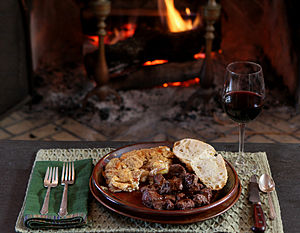
"Yonderian cuisine" is the collective term for the styles of cooking associated with Yonderre famous worldwide not least thanks to Yonderian cinema. Yonderian cuisine originated as the mixture of the Gothic peasant population's own local produce and the cooking styles and mannerisms of the Burgoignesc burghers and nobility. It was enhanced by cooking techniques developed in the mid-nineteenth century and the wider availability of goods during and after the Yonderian Golden Age and industrial revolution. Ground meats (pork, veal or beef) became widespread during the industrial revolution and traditional dishes that are still popular includes meat balls, breaded pork patties and sausages. Yonderian cuisine is known for its beers, fine wines, pastries and herbal liqueurs such as Chevaleuer Verte worldwide, all of which are widely exported with relatively little import of the same to Yonderre.
As the crossroads of central Levantia, cooking in Yonderre has always been inspired by foreign and continental practises and the use of imported tropical spices like cinnamon, cardamom, nutmeg and black pepper can be traced to the Yonderian cuisine of the Middle Ages and some even to the Khovihnihk peoples who inhabited northern Yonderre until the Great Gothic Migration in the late sixth century. Yonderian cuisine as a definitive singular category came about as a concept during the Yonderian Golden Age in the mid-nineteenth century, seeking to merge the many regional cuisines and specialities into a single, combined cuisine. The concept was largely succesful although regional specialities remain, enabling culinary tourism to thrive since.
Music
Crooners like Dom Martinez and François Artanis took Yonderre by storm in the 1950s and 60s, having come up from shows in the clubs of Gabion in the 1940s with a blend of proto-stand up slapstick comedy and singing. A vivid rock music scene emerged in the 1970s that lead to a plethora of rock and music genres played throughout the 1980s, producing iconic bands like Crusaders and Exception. Edith d'Alisse is an up and coming star in pop music, winning the WorldVision 2026.
Sports
The Yonderre national football team is among the best in the world, having been ranked in the top since the 1980s. The Yonderian football league is among the highest rated of all football leagues. The Federation Rasslin Yonderre (FRY) is one of the most watched purveyors of sports entertainment in the world since the 1980s, delivering professional wrestling and dramatic plotlines to worldwide audiences from weekly shows and special pay-per-view events.

